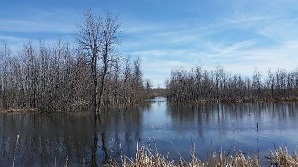Hunting and Trapping Newsletter
The New York State Department of Environmental Conservation sent this bulletin on 11/23/2021 12:54 PM EST |
| DEC Delivers - Information to keep you connected and informed from the NYS Department of Environmental Conservation |
| Share or view as a web page || Update preferences or unsubscribe |
Hunting and Trapping Newsletter |
Epizootic Hemorrhagic Disease (EHD) UpdateEarlier this year, New York State experienced several outbreaks of epizootic hemorrhagic disease (EHD) in white-tailed deer. These outbreaks primarily impacted deer in the central Hudson Valley, Eastern Lake Ontario region, and Long Island. The disease doesn’t affect humans but is transmitted to deer by a biting midge. Because the midges die in cold weather, the EHD outbreak has concluded in most of New York. Although the disease is usually quickly fatal for deer, DEC has seen evidence that a few deer survived infection. Though uncommon, deer that survive EHD can develop chronic signs that may be seen by hunters or others who observe deer. One of the most readily identifiable clinical signs of a deer that has survived EHD is the presence of cracking or sloughing hooves (see photos below). High fever during the acute illness causes the hoof wall to swell and separate from the underlying toe several months later. Deer with this condition may have difficulty walking or appear lame. Since these deer survived the initial EHD infection, they may also carry antibodies that would provide them with some level of immunity from future EHD outbreaks. DEC and Cornell University are in the process of sampling deer for the presence of EHD antibodies, and any deer harvested or observed with sloughing hooves should be reported through the online reporting form at the link below for potential tissue and blood sampling. Thank you for your assistance. https://survey123.arcgis.com/share/6c0603ce13444102be6858bc7dd577e9
Take It -Tag It - Report It!Remember to report your deer, bear, and turkey harvests this fall! Harvest reporting is faster and easier than ever, and is required by law within seven days of take! You may report your harvest:
Questions or problems with your harvest report? Call our deer management hotline at 866-472-4332 for assistance (Monday-Friday, 8 a.m. – 4 p.m.). DEC wants to remind hunters to enter the drawing for the January Firearms Deer Season on DEC-managed lands in Suffolk County. The deadline to enter is December 6th. DEC Adopts New Wildlife Management Area Regulations
DEC’s Division of Fish and Wildlife manages 125 WMAs and several Unique and Multiple Use Areas. These properties (known as the WMA System) are scattered across the state for your use and enjoyment. Together, these areas contain around 250,000 acres. Visitors to New York State's WMAs should always be aware of the rules governing the WMA. Each WMA has a webpage that lists featured activities, available facilities, any site-specific restrictions, and a map of the area. Photo of Ashland Flats WMA in Jefferson County by Sandy Van Vranken. NY Coyote Parasite SurveyAs part of a surveillance study for an emerging zoonotic parasite (Echinococcus spp.) in New York, graduate students at SUNY College of Environmental Science and Forestry are asking for public assistance in the collection of samples. Samples for this study consist of gastrointestinal tracts from coyotes harvested within DEC Regions 3-7, which can be shipped to SUNY ESF where they will be screened for the parasite. The parasite is a tapeworm that typically infects wild canids but can infect domestic animals as well as humans. The goal of this study is to identify the distribution of the parasite throughout the sampling range, so that areas of high parasite prevalence and infection risk can be found. Go online for more information on the project. Please contact Corinne Conlon with any questions. Conservationist Magazine Holiday Promotion
Gift a subscription of Conservationist to your friends and family. |


 Online
Online DEC adopted amendments to the regulations governing Wildlife Management Areas
DEC adopted amendments to the regulations governing Wildlife Management Areas Conservationist
Conservationist